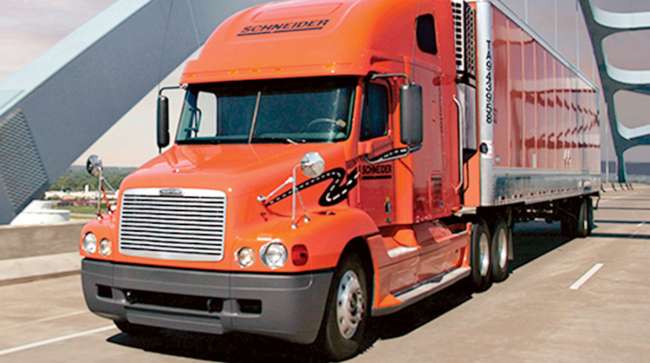Staff Reporter
Schneider Reports 6% Q1 Earnings Gain Despite Revenue Drop

[Stay on top of transportation news: Get TTNews in your inbox.]
Schneider National achieved a 6% year-over-year earnings gain despite a revenue loss during the first quarter of 2023, the company reported April 27.
The Green Bay, Wis.-based truckload motor carrier posted net income of $98 million, or 55 cents a diluted share, for the three months ending March 31. That compared with $92.1 million, 52 cents, during the 2022 period. Total revenue decreased by 12% to $1.43 billion from $1.62 billion.
Schneider ranks No. 8 on the Transport Topics Top 100 list of the largest for-hire carriers in North America, and No. 19 on the TT Top 100 list of the largest logistics companies.
“We obviously had a tough year-over-year comparison as last year was our most profitable first quarter in company history with adjusted operating earnings of $148 million,” Chief Financial Officer Stephen Bruffett said during a call with investors. “Contrast that with the challenging freight market conditions of this year’s first quarter, which were characterized by soft volumes, the absence of month-end surges and increasing pricing pressures.”
Schneider also noted that income from operations decreased 15% to $114.6 million from $135.1 million last year. The operating ratio was slightly worse going to 92.0 from 91.7 during the year-ago period. Operating ratio shows how efficient management is at keeping costs low while generating revenue. The smaller the ratio, the more efficient the company’s performance.
“Our first-quarter 2023 operating earnings of $115 million represented solid performance and our second-best first quarter,” Bruffett said. “Inherent in our results are some of the benefits of the portfolio restructuring we have strategically pursued and invested in over the past couple of years.”
Schneider has organized its investment priorities around a strategic framework that centers on maintaining a discipline approach to the allocation of capital with specific emphasis on targeted strategic growth drivers related to the dedicated, intermodal and logistics segments.
“Over the long term, we believe these strategic priorities enable growth, market share gains, more stable and resilient earning streams, and enhanced return on invested capital,” CEO Mark Rourke said in the call. “Secondly, our additional investment priorities involve our people, process, and technology efforts to deliver the optimal customer, carrier and associate experience.”
The results were mixed in terms of Wall Street expectations. Analysts had been looking for 46 cents per share and quarterly revenue of $1.51 billion, according to Zacks Consensus Estimate.
“Dedicated truck count grew 228 units year-over-year in the first quarter,” Rourke said. “The number of new business contract closures for late second-quarter and third-quarter implementations are very encouraging as we continue to prioritize growth and dedicated in our truckload segment. Our new business pipeline remains at historically high levels. In fact, dedicated solutions presented to customers in the first quarter is up 40% over the first quarter of a year ago.”
• Truckload revenue for Q1 decreased 2% to $537 million from $548.4 million year-over-year. The decline was due to lower network price and volumes that was driven by moderating market conditions. This partially was offset by the impact of dedicated new business growth. Income from operations fell 48% to $62.6 million from $119.4 million. This was due to the net gain on property sale in the first quarter and pricing pressures in the network that were partially offset by dedicated growth.
“We are in position to close the year with several hundred more units of organic tractor growth,” Rourke said. “Additionally, we are actively pursuing potential inquisitive opportunities that complement our dedicated organic growth initiatives and overall enterprise growth strategy.”
• Intermodal revenue slipped 12% to $266.1 million from $302.1 million in 2022. The report noted this was due to lower volume and price. Revenue per order decreased 2% compared with the first quarter a year ago. Income from operations declined 23% to $30 million from $38.9 million. This also was due to lower volume and price that were partially offset by increased dray efficiencies and lower rail-related costs.

This special "Inside The List" episode features the Transport Topics 2023 Top 100 largest logistics companies. Hear the program above and at RoadSigns.TTNews.com.
“We are focusing on our new and existing strategic rail partnerships and the broader positioning of the offering for volume recovery,” Rourke said. “Overall rail fluidity has improved as we are experiencing less friction and delays associated with the container dwell time at customer loading and unloading locations as well as within the rail terminals. With the transition to the Union Pacific, we are experiencing an improved network fluidity and service reliability.”
• Logistics revenue decreased 30% to $382.2 million from $545.7 million last year. This was primarily due to continued declines in spot rates that negatively impacted revenue per order and lower brokerage volumes year-over-year. Income from operations decreased 56% to $18.5 million from $41.9 million. This was due to lower net revenue per order and brokerage volumes as well as reduced earnings from port dray activity.
Want more news? Listen to today's daily briefing below or go here for more info:




